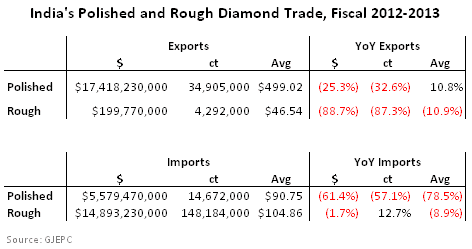There is always an attempt, a psychological one, to sugar coat bad news. This is not healthy, at times misleading, and at the end of the day, stands in the way of taking the steps necessary to turn bad into good. India’s diamond import and export figures for fiscal 2012-2013 were published earlier this week, exposing deep, often double-digit, declines in the country’s global diamond trade. It’s important to examine these results because India is the leading diamond trading and manufacturing center, and as such, what happens in India, highlights what happens in the global diamond trade.
Deep declines
Polished diamond exports from India in the April 2012-March 2013 period dropped 25.3 percent year-over-year to $17.42 billion. The volume of polished diamond exports fell 32.6 percent to 34.9 million carats, according to India’s Gem & Jewellery Export Promotion Council (GJEPC).
Most news outlets focused on the improved March figures or the overall gem and jewelry results, but examining the year as a whole has its advantages. All the small short-lived kinks are smoothed out and a fuller picture reveals itself. In this case, the full picture is that the past 12 months were not good for the diamond industry.

Falling exports = shrinking demand
Buyers in the consumer markets cannot purchase goods that are not exported from a manufacturing center. However, this is not just a ‘Push’ system, where suppliers feed consumers, this is primarily a ‘Pull’ system where consumers express an interest that fuels supply.
Rough diamond imports by India in the period, softened by 1.7 percent to $14.9 billion while the volume increased 12.7 percent to 148.2 million carats. This is a small change from the previous year, and clearly out of sync with exports. This shows that Indian diamond manufacturers may have expected a shift to lower-cost goods, but did not act as if a decline in demand is ahead of them.
They stocked up on lower-value goods – down 8.9 percent on average – but still sold less.
India is a glaring example of what has happened to the diamond industry in the past year – a decline in diamond jewelry demand by value that is contrary to all expectations for growing consumer demand against declining production.
The round-tripping effect?
It’s possible that the above conclusion about India is complete nonsense because it doesn’t take into account the demise of round-tripping. After a 2 percent duty was set on polished diamond imports near the end of the 2011-2012 fiscal year, polished diamond imports dropped sharply, as the above table shows.
Let’s assume that the nearly $9 billion decline in polished diamond imports is entirely round-tripping and that the goods were priced at the same value when exported. This means that we should subtract $9 billion from the 2011-2012 exports, leaving us with $14.4 billion of “genuine” exports during that year.
With that figure in mind, polished diamond exports in fiscal 2012-2013 have actually increased by more than 20 percent. Is it possible? In support of this theory is the 16.6 million carats in additional rough diamond imports. A yield of about 22-25 percent will generate approximately 4 million carats of polished that at an average value of almost $500 p/c, makes an additional $2 billion worth of extra polished available for export.
Tack this $2 billion to the assumed $14.4 billion of real exports brings us to ~$16.4 billion worth of polished diamonds, close to the reported polished exports in 2012-2013. If this back of the envelope calculation reflects what really took place, then where is the extra $1 billion of goods coming from? Possibly a combination of inventory sales, increases in the value of stocks and maybe there is still some round-tripping going on. Do all these assumptions hold water?
Reported declines is not the full story
Polished diamond exports from Belgium and Israel, the two other main diamond-trading centers, have also declined in the period. This is an overall trend plaguing the industry – but not entirely. For example, China is both a large polishing center and consumer market. There is a possible shift in China to locally polished goods due to tax advantages – no tax on rough imports, while polished imports are taxed. This means that consumer consumption could increase without it necessarily being reflected in exports to China.
High-end brands are reporting a continued increase in business thanks to high-income individuals who travel and buy top brands. This explains the good demand for top color and clarity as well as larger size diamonds.
There are plenty of additional pockets of strong business in the diamond jewelry trade, but they do not negate the overall story – one of a continuing murky economic situation, a slowdown in personal income growth and very limited advertising for diamond jewelry. Together, they result in mediocre demand for diamond jewelry and a shrinking business environment.
